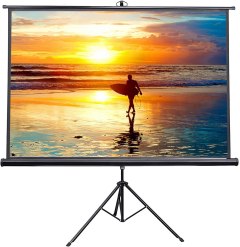Buying guide for Best projection screens
Whether you’ve got a full-fledged home theater projector, a mini projector for traveling, or a short-throw projector for work meetings in close quarters, you’re going to want a good screen. Projection screens play a huge role in image quality, so choosing a quality projection screen is just as important as getting a quality projector.
Projection screens come in all shapes and sizes, with many designed around specific uses. For example, some are portable, so they’re easy to take apart and carry around, while others are designed to be permanently installed in a viewing room. You can even build a setup for using your projector outside – some models are designed to help you turn your backyard into a drive-in theater.
Key considerations
Bring your projection screen search into focus by considering these questions.
Will you be traveling with your projector and screen?
If you’ll be using your projector and screen in multiple locations, limit your search to portable models. Portable projection screens often include a stand and a tube-shaped case for easy transport. In most instances, that also makes them a little more expensive.
Do you need a motorized projection screen?
Maybe we’re nerdy, but there’s something fun about using a motorized screen. One click on the remote and the screen slowly begins its descent or starts to crawl back up out of sight. Motorized screens are perfect for situations in which you want access to a big screen but you want it hidden the rest of the time. As you might expect, motorized projection screens are among the most expensive, so if it’s a luxury you don’t need, you can save a good chunk of money.
What size image will you be projecting?
Take a moment to make a plan for your projection screen. How big does it need to be? Your ideal image size will dictate the size of the screen you need, and, of course, the bigger the screen, the higher the cost.
Projection screen features
Once you’ve got a general sense of the size and kind of projection screen you want, keep these additional features in mind. They can make a good projection screen great.
Remote control
If a projection screen has any motorized parts, it will come with a remote for controlling it, which is a lot easier – and more consistent – than doing it manually.
Premium materials
Construction: The materials that make up your projection screen have the biggest impact on picture quality. For example, some luxury projection screens use black velvet on the borders to prevent light from “bleeding” off the edges of the screen. Similarly, a lot of projection screens have a black backing, which prevents light from getting through and reflecting on the wall behind.
Mounting: Most projection screens include hardware for mounting the screen on a wall, but the quality of those mounting components can vary. In the best cases, you’ll find kits that adjust for a variety of situations and include metal screws and brackets. (If you see a projection screen with a mounting kit made up of plastic pieces, don’t buy it.)
Projection screen prices
Inexpensive
Entry-level projection screens cost between $30 and $100. The models in this price range are pretty basic: they’re made of so-so quality vinyl, and they all open and close by tugging on a string. If you’re buying a projection screen for a one-time event or the occasional casual viewing session, you can find good options in this price range.
Mid-range
Some of the best values in projection screens cost between $100 and $300. In this price range, you’ll start to see some valuable upgrades: better-quality vinyl, motorized stands, or even a carrying case. If you’re building a modest home theater or a projection setup for a small business, this is the price range to watch.
Expensive
Luxury projection screens cost between $300 and $900. Screens in this price range get closer to being movie-theater quality (although it should be noted that real-deal movie theater screens cost anywhere from $9,000 to $40,000). If you’re building a no-holds-barred home theater, plan on spending this much.
Tips
Look for details about how to clean each model as you shop. Projection screens get dusty, and dust isn’t very reflective, which means that it can degrade your projector’s image quality if you’re not careful. Most projection screens can only be washed with soap and water because harsh chemical cleaners can degrade the screen or leave a residue behind. Once you’ve got your search narrowed down to a few models, read through some of the details to get a sense of how to clean it before you buy it.
Check user reviews to see how different portable models hold up over time. When it comes to portable projection screens, durability is a big deal. A single hole can render the whole screen useless. Check for reviews that specifically discuss whether it’s really suited for travel. If you see a lot of users complaining about damaged screens or stands, avoid those.
Mount a soundbar underneath the projection screen. Projector speakers aren’t usually amazing, so a lot of projector owners opt for a soundbar instead. If that’s part of your plan, do some measuring ahead of time. Figure out where the bottom of your projection screen will be, and make sure the soundbar fits underneath it. Keep in mind that you might have to raise your projector screen a little to get it situated. In general, a soundbar should be mounted at the same height as the viewer’s ear.
FAQ
Q. How far away should I sit from a projection screen?
A. It depends on how big the projected image is. In this case, projectors are just like TVs: you want to sit close enough to appreciate the detail but not so close that you have to move your head to see different parts of the screen. The best way to find the ideal sitting distance for your circumstances is to start with the measurement of your projection screen (diagonally), and then search for a projector viewing distance calculator online, which will give you a precise recommendation. In general, a 120-inch screen is best appreciated from about 15 feet away. Trust your eyes above all else. If you experience any eye soreness or vision concerns, consult your doctor immediately.
Q. How much do projector screens typically weigh?
A. It depends on what kind you get, but in general, projector screens can weigh anywhere between 18 and 40 pounds. Construction materials play a big factor in this. Portable projector screens are lighter, so you can carry one around, and motorized screens are heavier because of the mechanical parts. None of them are what we would call light, but that’s actually a good thing. A projection screen made of flimsy materials wouldn’t last long.
Q. How difficult is it to install a projection screen? Should I hire a professional?
A. Projection screen installation is moderately complicated, but if you’ve got experience with a drill (and a little patience), you should be able to install it yourself. You’ll be mounting a frame to a wall or a ceiling, so if you’ve drilled into your studs before to hang things up (like a TV mount), you’ll have no problem setting up a projection screen. If you’ve never drilled into your walls before, consider consulting a professional contractor.
























